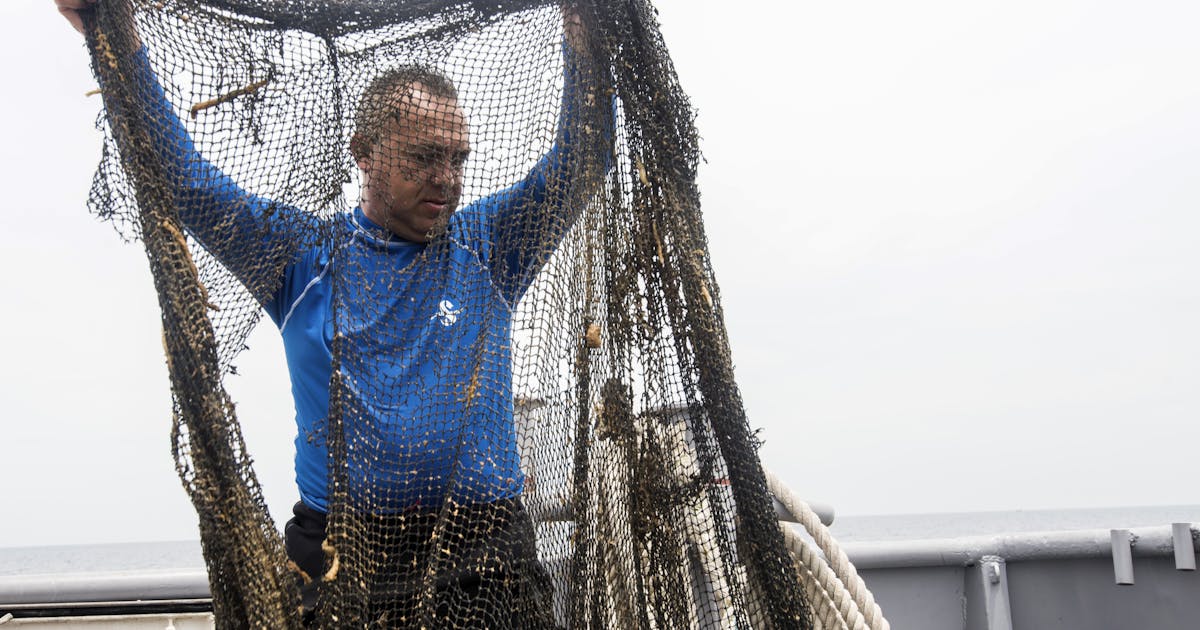Editor’s note: Throughout the world’s oceans, a silent plague is snaring marine life and smothering seafloors. Ghost nets — commercial fishing nets that are left behind or lost — can drift for thousands of miles, injuring or
killing fish or whales that get tangled in them.
Now, a small army is being recruited to help remove them wherever they’re found. One of the main figures behind this effort, Conservation International Marine Safety Officer Edgardo Ochoa, explains.
Working on the ocean is often a source of great enjoyment: You get to see extraordinary things such as coral reefs and exotic species and revel in the vastness of the open sea. But, sometimes it can be a source of emotional turmoil.
Last month, as I was teaching local community members and Conservation International staff about removing ghost nets at a workshop in Nuquí, Colombia, we had a shocking and up-close glimpse of the problem: Several locals came to me and said
they had spotted a humpback whale nearby with its tail caught in a net. I am certified in removing nets from the ocean, not from marine life, but I went out looking anyway.
I didn’t see the whale, but a few weeks later, I learned that the net had severed the whale’s tail. Whales
can survive without their tails by using their pectoral fins to swim and dive, but it takes much more effort and slows them down. This is a very sad sight to see, and unfortunately, it’s not uncommon.
Ghost nets — commercial fishing equipment and nets that are left behind or lost— can injure and kill marine life by entrapping them
and either damaging vital body parts such as the tail, or trapping them underwater and drowning them. All told, ghost nets comprise nearly half of the plastic trash found in the ocean, according to a recent study.
I made it my mission to help remove them. But there are more nets than any one person or government agency can extricate — and even then, we don’t know where these nets are until scuba divers happen upon them.
There are only a few professional technical divers who are trained in removing these nets — yet there are at least 6 million recreational divers in the world. Who better to enlist to help solve this problem?
So by working with PADI (Professional Association of Diving Instructors), the global diver training organization, I helped to create a ghost-net-removal course that any certified recreational diver can take. The new course trains non-professional
divers to remove nets that are up to 60 feet deep using simple equipment from the hardware store. It’s as simple as being on vacation, seeing a fishing line and having the knowledge of knowing where to cut it to remove it safely.
By showing ghost net removal can be fun, we are able to reach a broader audience and get more people to help. Involving recreational divers in ghost net removal isn’t citizen science — it’s citizen empowerment. It’s a hands-on
experience that allows people to get out and do something beneficial together.
For me, as a biologist, removing ghost nets is a combination of calculation and excitement. I’m always looking for patterns when I dive, something that’s out of the ordinary. The first step is recognizing that something isn’t quite
right — unnatural shapes such as straight lines or triangles hint at something manmade — something that doesn’t belong. So, next I go check it out and notice a fishing line or the weave of a net. I pull to see how large it is
and follow it around one side or another.
For me, the fun is executing the removal of a net. I start thinking to myself, ‘Okay, if I start cutting here and put this there, I need another lift bag here.’ As a photographer, I can picture the way the net is entangled in my mind and
better understand how to remove it successfully.
I am overjoyed to see communities and non-professional divers get as excited as I do about the removal of these nets, and I’m optimistic of the future of ghost net removal and marine health — thanks to citizen involvement.
Edgardo Ochoa is a marine safety officer at Conservation International.

